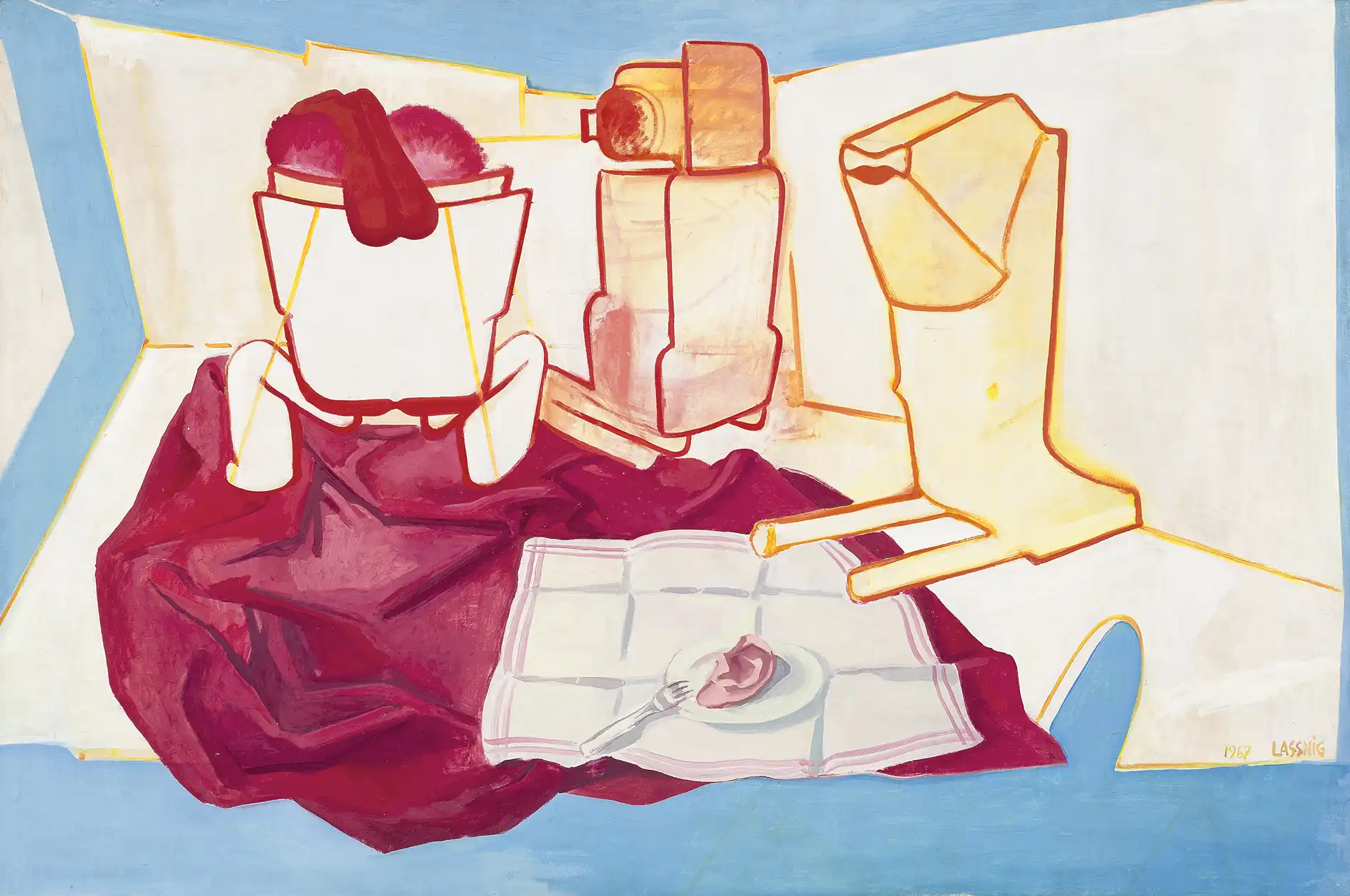Born in 1919 in rural southern Austria, Lassnig enjoyed a seventy-year career in painting, drawing and animation. Drawing on the close relationship between Lassnig and curator Hans Ulrich Obrist, this presentation aims to revive the French public’s interest in the artist’s groundbreaking work, which shaped the history of modern and contemporary art through the concept of body consciousness (Körpergefühl) and her feminist commitment. Her last solo exhibition in France took place in 1999 in Nantes, at the Musée des Beaux-Arts de Nantes and the Fonds Régional d’Art Contemporain des Pays de la Loire.
In Lassnig’s early work, Expressionist and Surrealist influences predominate, followed by those of Art informel and Nouvelle Figuration. These movements nourished Lassnig’s approach, based on the representation of the body’s inner sensations rather than its outer appearance. Colors vibrate, and figures spring from an understanding of the “micro-world of millions of neurons”, unreachable by any photographic device. Considered one of the greatest Austrian painters since Egon Schiele and Oskar Kokoschka, Lassnig has been the subject of over a hundred books. She also inspired the biographical film Sleeping with a Tiger, which premiered at the Berlinale in 2024, and the play Alte Meisterin. Lassnig/Beresin/Bitzan, 2024. A leading figure in post-war art, she remains an essential milestone in the evolution of European painting.
Hans Ulrich Obrist discovered Lassnig’s work during his childhood, when he bought a postcard reproducing one of her paintings, which was later carefully stored in his homemade “shoebox museum”. In 1986, at the age of seventeen, he took an overnight train to Austria, where he met Lassnig in his studio on Vienna’s Maxingstrasse. At the time, the artist was teaching painting and animation at the University of Applied Arts. Lassnig introduced Obrist to the work of the Austrian poet Friederike Mayröcker, encouraging him to read her more deeply. She later facilitated the meeting between Obrist and Mayröcker, who became a close friend until her death in 2021.
From 1993 to 2014, Lassnig and Obrist regularly exchanged letters and frequently met in the artist’s Viennese studio. In 1993, when Kasper König invited Obrist to co-direct the exhibition The Broken Mirror as part of the Wiener Festwochen (Vienna Festival), Lassnig’s paintings and the film The Ballad of Maria Lassnig, 1992, shown at the opening, formed a major pillar of this retrospective devoted to painting.
In 2000, Obrist helped Lassnig publish her diaries from 1940 to 1997, revealing the extent of her artistic doubts and the evolution of her singular body-conscious practice. Although Lassnig was generally reserved about formal interviews, in 1999 she allowed him to film her, inaugurating a series of conversations recorded until 2012. Subsequently, in 2005, he collaborated with Daniel Birnbaum and Akiko Miyake to select Lassnig for the museum in progress Safety Curtain project at the Vienna State Opera, reproducing her oil painting Frühstück mit Ohr, 1967.
When Obrist joined the Serpentine teams in 2008, he and Julia Peyton-Jones organized a major exhibition at the Serpentine Gallery, with the support of Maja Hoffmann. A decade later, in 2017, having conceived it with Maria Lassnig, Obrist finalized in Athens a posthumous exhibition centered on the artist’s passion for Greek mythology and guided by a poetic title borrowed from Friederike Mayröcker: The Future Is Invented with Fragments from the Past. After her death, Obrist remained close to the Maria Lassnig Foundation, briefly sitting on its advisory board (since 2016) and participating in the jury for the Maria Lassnig Prize, created on the artist’s initiative before her death to encourage artists who are little known to the public.
Gathered together for the first time in one place, the exhibition at LUMA Arles features video interviews between Lassnig and Obrist, as well as their extensive correspondence arranged in chronological order. Among the works on show are paintings from The Broken Mirror and Serpentine Gallery exhibitions, the project for the Vienna State Opera, and paintings and watercolors presented in Athens. Alongside the biographical film The Ballad of Maria Lassnig, the film Selfportrait, 1971, illustrates Lassnig’s pioneering exploration of animation within the New York feminist scene of the 1970s. Two of Lassnig’s canvases were last shown in France in 2023 at the Fondation Vincent van Gogh in Arles, in the exhibition Action, Gesture, Paint: Women Artists and Global Abstraction 1940-1970, a tribute to her admiration for van Gogh, whom she described as an “expressionist god” in a 2008 interview with Obrist. Echoing the phrase “Living with art prevents fading!” she penned for Hans Ulrich Obrist in her last unfinished letter, dated January 11, 2014, this presentation honors the vivid legacy of a painter whose inner visions continue to resonate in bodies and minds.

